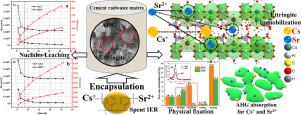Journal of Nuclear Materials ( IF 2.8 ) Pub Date : 2020-11-28 , DOI: 10.1016/j.jnucmat.2020.152701 Xingang Xu , Haifeng Bi , Yang Yu , Xinghua Fu , Shoude Wang , Yu Liu , Pengkun Hou , Xin Cheng

|
Radioactive ion exchange resin is a problematic waste requiring proper immobilization to ensure that the resin's radioactive ions are stable for storage and ultimate disposal in water environments, such as seawater or groundwater. Sulphoaluminate cement hardened paste, with the dense structure, great retention capacity for ions, and resistance to SO42− and Cl−, is a potential cementation material to encapsulate 137Cs+ and 90Sr2+ in radioactive ion exchange resin. The leaching rates of Cs+ and Sr2+ from the sulfoaluminate cement matrix solidifying radioactive ion exchange resin and their immobilization characteristics of the predominant hydration products (ettringite; aluminum hydroxide gel) of sulfoaluminate cement were investigated in depth. The experimental results showed that the sulphoaluminate cement radwaste matrix had a better retention capacity for Cs+ and Sr2+ than the OPC radwaste matrix. The 42 days cumulative leaching fractions of Cs+ and Sr2+ were 6.21 × 10−2 and 5.77 × 10−3 cm, respectively, which could be described by the FRDM or DDIM model for Cs+, and the DDIM model for Sr2+. The retention of Cs+ and Sr2+ originated from the chemical absorption by ettringite, aluminum hydroxide gel, and the physical barrier. The ettringite and aluminum hydroxide gel's retention rates for Cs+ are above 70% and 40%, respectively, while those of Sr2+ are above 88% and 10%, respectively. In detail, Cs+ and Sr2+ could be absorbed by both ettringite and aluminum hydroxide gel. Unlike Cs+, Sr2+ could enter the ettringite's crystal lattice by replacing Ca2+ and entering the negative channel.
中文翻译:

具有放射性IER的SAC基质中Cs +和Sr 2+的低浸出特性及包封机理
放射性离子交换树脂是一种有问题的废物,需要适当固定以确保树脂的放射性离子在海水或地下水等水环境中能够稳定存储和最终处置。硫铝酸盐水泥硬化膏,具有致密的结构,对离子大保留容量和耐SO 4 2-和Cl - ,是一种潜在的胶结材料来封装137 Cs的+和90的Sr 2+放射性离子交换树脂。Cs +和Sr 2+的浸出率从硫铝酸盐水泥基体中固化了放射性离子交换树脂,并深入研究了硫铝酸盐水泥的主要水合产物(钙矾石;氢氧化铝凝胶)的固定特性。实验结果表明,硫铝酸盐水泥垃圾废物基质对Cs +和Sr 2+的保留能力优于OPC垃圾废物基质。Cs +和Sr 2+的42天累积浸出率分别为6.21×10 -2和5.77×10 -3 cm,这可以通过Cs +的FRDM或DDIM模型以及Sr 2的DDIM模型来描述。+。Cs的保留+和Sr 2+源自钙矾石,氢氧化铝凝胶的化学吸收和物理屏障。钙矾石和氢氧化铝凝胶对Cs +的保留率分别高于70%和40%,而Sr 2+的保留率分别高于88%和10%。详细地讲,钙矾石和氢氧化铝凝胶都可以吸收Cs +和Sr 2+。与Cs +不同,Sr 2+可以通过取代Ca 2+并进入负极通道而进入钙矾石的晶格。











































 京公网安备 11010802027423号
京公网安备 11010802027423号